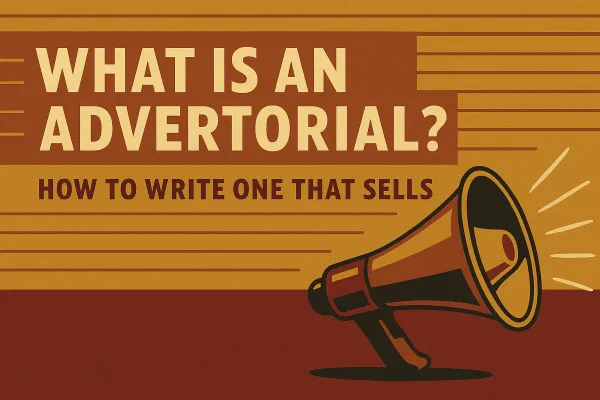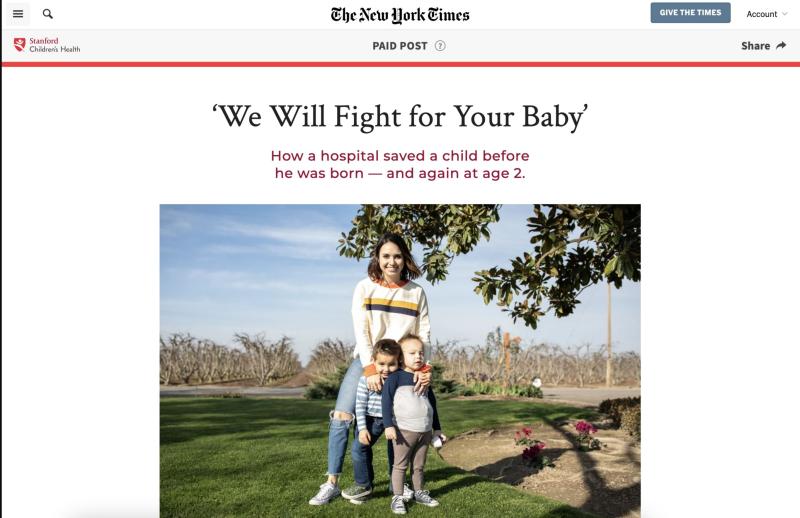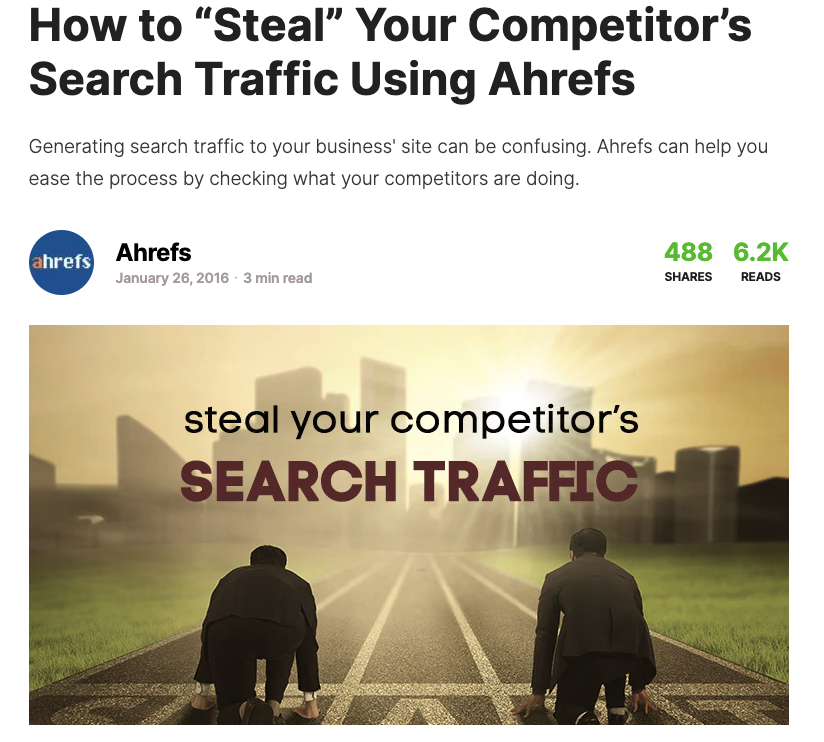
 Details
Details
What You’ll Learn in This Guide
- ✅ What an advertorial is—and why it works better than most ads
- ✅ How advertorials differ from native ads and sponsored content
- ✅ 10+ advertorial formats in 2025 —from video to quizzes
- ✅ The 6-step process to writing advertorials that convert
- ✅ What separates a good advertorial from a great one
- ✅ How to measure the success of advertorials —and keep optimizing for better results
Ready to write advertorials that actually sell?
If you’ve browsed a magazine or scrolled through an online article recently, chances are you’ve encountered an advertorial— perhaps without even realizing it.
That’s the magic of a well-executed advertorial: it blends in seamlessly with editorial content while subtly promoting a brand, product, or service.
But why are advertorials so effective?
Because ads are easy to ignore. Great stories aren’t.
So what exactly is an advertorial? How do they work—and what separates a forgettable one from a high-performing piece?
In this ultimate guide, we’ll cover everything from the definition of an advertorial to real examples, best practices, and a step-by-step process for writing advertorials that drive results.
Related: How to Spot Native Advertising? 8 Ways to Tell
What is an Advertorial?
At the Native Advertising Institute, we define an advertorial as follows:
An advertorial is a paid article that looks and reads like editorial content—but it’s created to promote a product, brand, or service.
As you may have notified, the word itself is a hybrid between the words "advertisement" and "editorial".
Think of an advertorial as a story with an agenda. It delivers value to the reader while steering them gently toward a call to action. No flashy banners. No pop-ups. Just content that informs, engages, and converts.
It might appear in a magazine. On a blog. In your favorite news feed. And if it’s done right, you won’t immediately recognize it as an ad.
Because a good advertorial is not just an ad—it’s an experience.
Unlike banner ads or popups, advertorials are less intrusive. They respect the reader's experience and fit naturally into the surrounding content, which is why they're often more effective than traditional advertisements.
Still curious?
Dive into The Ultimate Guide to Native Advertising and get even sharper.
Here are some examples of the different types of advertorials you may across in 2025:
Different Types of Advertorials
Print Media
A full-page spread in a lifestyle magazine crafted to read like an expert feature, showcasing a new kitchen appliance through storytelling, tips, and testimonials that align with the magazine’s editorial voice.
Online Content
A sponsored article on a popular travel blog that explores hidden gems in a destination, seamlessly weaving in the brand’s offerings—like tours, hotels, or travel insurance—as part of the experience.
Video Format
A video advertorial hosted on a major news or tech site, featuring a demo of a new app or device. The video uses a journalistic approach to explain the product's features, use cases, and user benefits.
Interactive Campaigns
An online quiz or tool on a wellness site that asks users questions about their habits or goals and then recommends a branded product or service tailored to their answers.
Collaborative Content
A co-branded content series between a media outlet and a brand, where both parties contribute to storytelling—such as seasonal style guides produced by a fashion magazine and a retail brand.
Native Podcasts
A sponsored podcast episode where the host interviews a guest from the brand, weaving promotional messaging into a conversational and editorial format.
Branded Infographics
An educational infographic highlighting market trends or statistics, distributed on business or news sites and subtly promoting the brand’s expertise or solution.
Social Media Takeovers
A brand collaborates with a media outlet or influencer to take over their social channels, creating story-driven posts or reels that highlight the product in an organic way.
Newsletter Advertorials
A sponsored content block embedded within a publisher's email newsletter, offering tips or insights that naturally lead into a brand’s product or solution.
Live Experiences / Webinars
A branded webinar or virtual panel hosted with a media partner, designed to deliver value while featuring the brand’s perspective, solution, or experts.
Mini-documentaries
A short-form video that tells an emotional, real-world story (like a customer success story) with subtle branding throughout—often resembling an editorial documentary.
Advertorial vs Native Advertising: What’s the Difference?
Advertorials and native ads are close cousins—but not twins.
Native advertising is a broad category. It includes any paid media that matches the form and function of the platform it appears on. Think: sponsored posts, in-feed ads, promoted listings.
An advertorial, on the other hand, is a specific type of native ad. One that looks like an article. Reads like an article. But still sells.
The tone is more direct. The message is promotional. And the goal? Conversion.
Key Differences Between Advertorials and Sponsored Content
Advertorials and sponsored content are often confused, but they serve distinct purposes.
Sponsored content focuses on building brand awareness and trust, offering valuable information or entertainment in collaboration with the publisher.
It is less promotional and even more aligned with the publisher's regular editorial tone, positioning the brand as a thought leader without making a direct sales pitch.
On the other hand, advertorials are more overtly promotional. While they mimic the editorial style of the platform, their primary aim is to drive conversions, such as product purchases or service sign-ups. Advertorials often have a clear call-to-action, leading the reader toward a specific action.
In terms of creation, sponsored content usually involves closer collaboration with the publisher to ensure it aligns with the platform’s voice and audience, while advertorials are typically produced by the brand or an agency.
Both require transparency, with sponsored content often labeled as “sponsored by” and advertorials marked more clearly as "advertisement" or "paid post" to ensure readers understand the nature of the content.
Ultimately, sponsored content helps build long-term brand trust, while advertorials are designed to generate more immediate results, like sales or leads.
The Components of a Great Advertorial
Let’s break it down. A scroll-stopping, action-driving advertorial isn’t built by chance. It’s built with intention. Here’s what separates the good advertorials from the great:
Engaging Content
Yes, we know—“engaging content” gets tossed around a lot. But when it comes to advertorials, it’s non-negotiable. Your story has to hook, hold, and help. Think storytelling over selling. Substance over slogans. Give readers something worth their time.
Example:
The New York Times partnered with Netflix to promote "Orange Is the New Black" with an in-depth advertorial feature on women in U.S. prisons. It read like investigative journalism—and readers were drawn in.
The campaign earned massive visibility for the show—and the piece remains a standout example of how a great advertorial lets the story shine on its own.
Smart Brand Integration
This isn’t the place for hard-sell headlines or pushy promo copy. Great advertorials weave the brand into the story—not the other way around. The brand supports the narrative, not hijacks it. If it feels like an ad, you’ve already lost.
Example:
BuzzFeed's collaboration with Google Play for Star Wars Day didn’t scream “Download our app!” Instead, it featured fun, themed quizzes that subtly promoted the Google Play experience. Brand presence? Check. Forced messaging? Not even close.
A Clear Call to Action (CTA)
You’ve earned their attention—now guide it. A strong advertorial leads the reader to take the next step, whether that’s clicking through, signing up, downloading, or buying. No CTA? No results.
Example:
Ahrefs’ long-form guide on “How to Steal Your Competitor’s Traffic” (published in The Search Engine Journal) delivers SEO value upfront—then invites readers to try Ahrefs for themselves. The CTA is clear, relevant, and low-friction: Start your free trial.
Visual Storytelling
The best advertorials don’t just tell a story—they show it too.
Don’t let your words do all the heavy lifting. Use images, videos, or infographics to boost clarity and keep the scroll alive. A well-placed visual can carry your message further—and faster—than a paragraph ever could.
Want to see this in action? Just scroll down to our advertorial examples.
Why Advertorials Work (When So Many Ads Don’t)
Let’s face it—people are tired of traditional ads. They scroll past. They block. They bounce.
But advertorials get through. Here’s why:
They blend in. Placed within trusted media outlets, they borrow credibility from the publisher.
They deliver value. Readers get something useful or interesting—even if they’re being marketed to.
They drive results. Studies show advertorials boost engagement, conversions, and even brand recall.
Here’s a stat that says it all:
In a classic A/B test, an advertorial sold 81% more of a product than a traditional ad using the exact same copy, according to a study by Readers Digest. Same message—just a smarter format.
Example of an advertorial
Here’s what a great advertorial looks like out there in the real world. Stanford Children’s Health teamed up with The New York Times to tell a powerful story—one that reads like a feature article, not a sales pitch.

The sub-headline “How a hospital saved a child before he was born – and again at age 2" pulls you in like any strong editorial would.
It's clearly marked “Paid Post” at the top—transparency matters. But even so, the storytelling takes the lead, and the brand reveal feels natural. It’s clearly from Stanford Children’s Health, but more importantly, it’s a story worth reading.
READ MORE: The 12 Best Native Advertising Examples in 2025 [So Far]
Online Advertorials: Why Digital is the Sweet Spot
Online advertorials are where the magic happens today.
Why? Because they’re scalable, measurable, and perfectly placed for modern attention spans.
They can live on publisher sites, branded blogs, or as sponsored content in newsletters and social media feeds. And thanks to smart targeting and SEO, the right people find them at the right time.
But remember: transparency matters.
Mark your advertorial as “sponsored” or “paid post.” Use rel="sponsored" in your links. Don’t try to trick Google—or your readers.
Trust is everything when it comes to advertorials.
READ MORE: The Best Platform for Native Advertising Right Now
How to Write an Advertorial in 2025
We've identified six essential best practices for crafting high-performing advertorials:
- 1 Understand how the reader talks about your topic
Learn their language before shaping your message. - 2 Define and nail the angle of the advertorial
Choose a hook that grabs attention and adds value. - 3 Offer real value
Educate, inspire, or entertain before you promote. - 4 Weave in the brand
Integrate the product naturally—never force the mention. - 5 Match the publisher’s tone
Make it feel like it belongs. Editorial fit is everything. - 6 End with a strong CTA
Guide your reader to the next step—clearly and confidently.
1. Understand how the reader talks about your topic
Before you write a single word, ask yourself this: Who are you talking to—and what do they actually care about?
Great advertorials start with empathy. You need to understand your reader’s world:
What keeps them up at night? What questions are they Googling? What challenges are they trying to solve—right now?
This isn’t guesswork. Dig in.
💬 Browse Reddit threads, Quora questions, and niche Facebook groups.
🛍 Read customer reviews—especially the 5-star love and the 1-star rants.
🔍 Scan the comment sections of your competitors’ blogs and YouTube channels.
Look for patterns. Listen to the language they use. Pay attention to pain points, objections, desires, and “aha” moments. That’s your gold.
Why does this matter? Because when you write in their language—not yours—you instantly build trust. You’re not pushing a product. You’re offering a solution to something they already care about.
Speak like them. Think like them. Solve like them.
Do that—and you’re already halfway to a high-performing advertorial.
READ MORE: Native Advertising vs Display Ads: Which Leads to Better ROI?
2. Define and Nail the Angle of the Advertorial
Don’t just start writing. Start with intent.
An advertorial without a strong angle is just content. And content without purpose? Easy to ignore.
To hook your reader, you need to come in sharp—with a clear, specific, and irresistible angle.
Your headline does the heavy lifting here.
LEARN MORE: How to Write Native Ad Headlines that Boost Performance and Guide to Native Ad Headline Generators
The headline should promise something your audience wants—a solution, a revelation, a benefit they didn’t know they needed. And your story? It needs to deliver on that promise.
Let’s go back and look at the advertorial example from Stanford Children’s Health that we mentioned previously.
Their headline? “How a hospital saved a child before he was born – and again at age 2.”
That’s not just a title. That’s a human story with emotional pull. It makes you want to read more—because it taps into something real.
Or take the example below of Walmart’s sustainability advertorial in The New York Times.
The angle wasn’t just “Walmart is going green.”
It was a bigger story about environmental impact, told through the lens of one of the world’s biggest retailers. The reader walks away informed—and Walmart walks away looking like a leader.

So how do you find your angle for your advertorial? Ask yourself:
What challenge is my audience facing?
What’s the most interesting or unexpected part of this brand’s story?
How can I deliver value while naturally leading toward my CTA?
Bonus tip: Stick to the editorial tone of the platform you’re publishing on. If your angle feels out of place or off-brand for the outlet, you’ll break trust—and lose the reader.
In short: Lead with a killer hook. Deliver a tight, valuable narrative. Keep it native.
Your angle is your edge. Use it wisely.
3. Offer Real Value
Here’s the truth: If your advertorial doesn’t give the reader something useful, they’ll bounce—and they won’t be back.
This isn’t just about clever copy or clean design. Your content needs to stand on its own. It should teach something, solve something, or inspire something. That’s the value exchange: their time for your insight.
Put yourself in their shoes and ask:
“What’s in this for me if I don’t care about the brand?”
If the answer is not much, rewrite it.
Great advertorials don’t lead with the product—they lead with a problem your reader cares about. Then they offer insights, tips, data, or a fresh perspective that helps. Only once the value is delivered should the brand naturally enter the conversation as part of the solution.
Need inspiration to what that value could be?
A fitness brand shares a 5-step guide to beating burnout—and casually introduces its recovery products along the way.
A software company explains how to streamline your workflow—and uses their own tool as a subtle case study.
A travel brand shares the 10 most affordable digital nomad cities—and recommends their insurance or booking app near the end.
Bottom line: Lead with what helps the reader, not what helps your bottom line.
Educate while you sell—and suddenly, you’re not interrupting their journey. You’re guiding it.
RECOMMENDED: 8 Essential Visual Techniques for Native Advertising
4. Weave in the Brand
Let’s be clear: An advertorial isn’t a sales brochure in disguise.
If your reader feels like they’re being sold to from the first paragraph, you’ve already lost them.
Great advertorials don’t shout the brand—they blend it in. They prioritize the story, the insight, the reader’s problem—and only bring the brand into the spotlight when it naturally fits.
A good rule of thumb?
🧠 70% valuable content, 30% brand presence.
That balance keeps your piece feeling editorial—not advertorial in the worst sense of the word.
Of course, this ratio shifts depending on your goal:
Building awareness? Keep it heavy on insight, light on the pitch.
Driving leads or conversions? You can be more direct—but still stay subtle.
Need a masterclass on how to weave in your brand in an advertorial?
Let's go back and take another look at Ahrefs’ long-form advertorial "How to “Steal” Your Competitor’s Search Traffic" published in The Search Engine Journal:
It’s packed with SEO tips, competitor strategies, and real examples—all super actionable. But along the way, Ahrefs gently introduces its own tools as the natural next step.
No pushy sales talk. Just smart integration.
The result? The reader learns something and sees how Ahrefs fits into the solution—without ever feeling pitched.
Takeaway:
Mention your brand when it makes sense in the story. Let the product support the content—not overshadow it.
5. Match the Publisher’s Tone
You’re not just buying ad space—you’re buying access to a trusted voice.
Break that voice, and you break the trust.
A successful advertorial sounds like it belongs on the platform it’s published on. That means mirroring the tone, style, and rhythm of the publisher’s regular editorial content—not your brand’s internal voice or usual marketing language.
Why? Because your reader didn’t land there to hear from you.
They came for the type of content that platform delivers—whether it’s punchy listicles, longform investigations, or straight-to-the-point how-tos. And if your piece suddenly sounds like a commercial break, you’ve lost them.
Let’s break it down:
Publishing on BuzzFeed? Think casual, witty, highly shareable.
Partnering with The New York Times? Go for depth, authority, and narrative-driven storytelling.
On a B2B site? Use industry insight and clear value props, minus the fluff.
Example:
Google Play Australia ran an advertorial with BuzzFeed for Star Wars Day. Instead of pushing downloads, it offered quizzes, memes, and a lighthearted tone that blended right into BuzzFeed’s usual vibe. The branding was there—but it didn’t disrupt the experience. It enhanced it.
Bottom line:
Stay in character. Speak the way the platform speaks. And keep the reader in the zone.
Because the second your advertorial feels out of place… it probably is.
LEARN MORE: How to drive results with sponsored posts on Facebook
6. End with a Strong CTA
Don’t fade out. End with a bang.
You’ve hooked them. You’ve delivered value. You’ve weaved in your brand like a pro. Now what?
Tell your reader what to do next.
That’s your CTA—your call to action—and it’s where the business happens.
A well-placed CTA isn’t just a button or a link. It’s the bridge between content and conversion. Without it, your advertorial is just a nice story with nowhere to go.
Here’s the secret: Your CTA should feel like the natural next step.
If your advertorial taught them something useful, offer a free tool.
If you told a powerful story, invite them to explore more.
If you positioned your product as the solution, guide them to try it.
It doesn’t have to scream “BUY NOW.” In fact, it shouldn’t. But it should be clear, relevant, and easy to act on.
👉 Subscribe to our newsletter
👉 Download the free guide
👉 Try the product risk-free
👉 Read the full story
👉 Donate and make a difference
Whatever it is, make it obvious—and make it matter.
Final Thoughts on Advertorials (for now)
Advertorials have become a core strategy in modern online advertising. When done right, an advertorial article educates, entertains, and drives results—without coming off as pushy or overly branded.
Whether you're a marketer looking to drive leads, a brand seeking awareness, or a publisher exploring new revenue streams, advertorials deserve a place in your content strategy.
Ready to craft your next high-performing advertorial? Bookmark this guide—and get started today!





